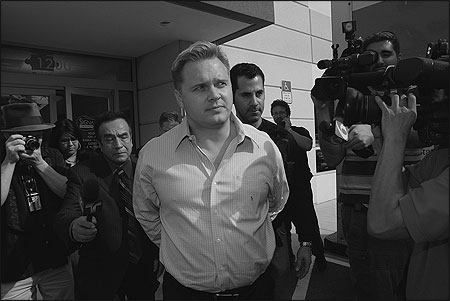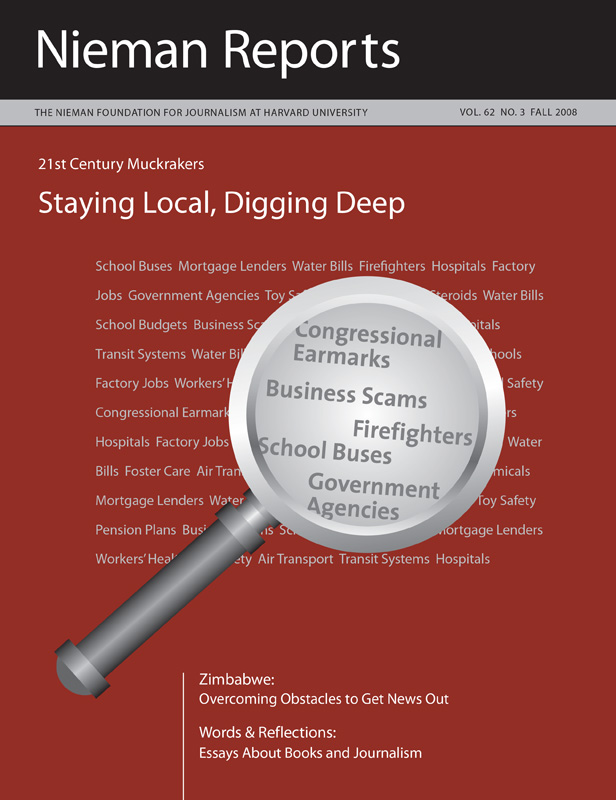
Law enforcement officials bring out boxes of items seized from the Signature Compounding Pharmacy in Orlando, Florida in February 2007 during a multiagency raid of the drug company. Photo by Paul Buckowski/Times Union.
It was 11 o’clock at night. I was standing in a motel room in central Florida about 1,200 miles from my newsroom near New York’s capital. A couple of Orlando TV stations were covering the story we’d broken that day, and pretty poorly. So I switched channels to CNN. They were on it. Clicked to ESPN. A couple sports-broadcast icons were discussing the latest steroids scandal to strike the sports world.
“Albany Times Union.” There, one of them said it. The words just hung there. I smiled. Not a bad national scoop for a medium-sized daily from upstate New York. CNN called to request an interview, as did another network and radio jocks across the country. But news was still breaking, and I wasn’t the story. I declined.
In the days that followed, reporters from nearly every major news organization parachuted into Orlando and also into our home base of Albany, New York. They were looking for a piece of the steroids investigation that revolved around a grand jury investigation initiated by our local district attorney.
The case was rattling the professional sports world. Wrestlers. Ballplayers. NFL stars. They all were on the customer lists of an Orlando pharmacy that investigators said had been peddling steroids to tens of thousands of customers in New York and other states. Dozens of doctors, pharmacists and wellness center operators were rounded up across Florida and hauled back to New York for arraignments on the sealed indictments.
Few of the good details were spelled out in court documents. But our investigative team at the paper had them, including names. We broke the story on our Web site (to the consternation and anger of some of the investigators) not long after the multistate task force kicked in a door or two and rocked those pharmacists’ worlds. Now readers wanted names. Who were the cheaters? Any New York Yankees on that list?
Applying the Basics
In Albany, the local media was frothing mad and claiming favoritism had resulted in us getting this story. (Full disclosure: Early on, Sports Illustrated had a team on the story, but we pulled the trigger first.) But landing the story really came down to basics—careful sourcing and meticulous reporting, factors that have always been the cornerstone of solid investigative journalism. But for this story to happen in these times—with newsrooms in tough shape and reporters under pressure to produce a lot of stories and do so today—another key building block had to be in place. We needed the total investment of our editors, our newspaper’s publisher and, in turn, Hearst Corporation executives. All of them had to be steadfast in their decision to dedicate resources to the work of a small investigative team and let this team spend considerable time—if needed, and to the envy of other reporters—hunting down big stories.
Our local competition, mostly some TV stations and a foundering daily, weren’t aware that this story had been quietly unfolding for months in the public courtrooms of Albany County. One of the first arrests in the case took place long before the Florida pharmacy raids. It involved an alcoholic physician with a revoked medical license who was arrested and hauled into court in Albany because she ignored investigators’ warnings to stop writing phony Internet prescriptions. (There were also three people from Houston who were indicted and brought through our local airport in handcuffs. Law enforcement officers did tip us off about the significance of these unusual arrests that if seen as separate incidents didn’t seem like much.)
For us, time spent cultivating sources on this case helped to bring the broader story into focus. The more we learned, the more we realized this was a major and unprecedented case, sparked by a years-long probe within the state’s Bureau of Narcotic Enforcement. Internet prescriptions. Steroids. Painkillers. Everything a pharmacy can produce was being doled out to nearly anyone with a computer and a credit card. Congress had warned about this new frontier in the war on drugs, and the Albany investigators joined forces with a Florida task force. Because New York’s prescription laws were among the toughest in the country, the Florida suspects, who did millions of dollars in illicit business in New York, were going to be prosecuted here.
As our questions made it apparent how close we were to breaking this story, law enforcement sources pulled us aside and explained the consequences of exposing their investigation. They asked us for an embargo. In return, they gave us an assurance we could be on the story when they raided the pharmacies. We handled this situation in the way a news organization embedded with a military unit would deal with a request to delay reporting on a planned air strike.
Even as we reached this agreement, we were going harder on the reporting. I flew to Florida and photographed and visited one of the Palm Beach County wellness clinics seven weeks before it was raided. We cultivated a wider net of sources, and they were the ones to help us weave the story together. It was a tense time, because Sports Illustrated had a dogged reporter on the story, Luis Fernando Llosa, and he seemed to know more about a related investigation in Alabama that had implicated heavyweight boxing champ Evander Holyfield. In the end, Sports Illustrated had greater detail in their report, but the Times Union got credit for breaking the story.
This became our first major strike for the Times Union’s three-person investigative team that had been formed about a year prior. I am convinced that what put us in a position to land the story was the decade of experience I had in cultivating sources within the law enforcement community. Back then, an editor at a different newspaper—a former Marine with a storied journalism career who’d spent more time in war zone, as a journalist, than most soldiers—asked me to take on that beat.
Once on the beat, he wasted little time in teaching me how to break the mold. Too many cop reporters hang out with the cops, he said. That’s understandable, since in many ways cops and reporters share a bond: A lot of people don’t trust either one of them. So this editor pulled me into his cubicle and told me the paper wanted a cop reporter who’d also focus on police corruption. We need incisive coverage, he explained, and that’s how my work as an investigative reporter began.
Despite the nationwide attention with our steroids series, I find that most Times Union readers still relish the local scandals we uncover, and that’s why two projects we did this year resonated with them. The first exposed real estate frauds by a former Urban League director and his partner, an iconic city detective; the second centered on the secret and illegal purchases of federally regulated machine guns by dozens of city cops and some civilians, including a prosecutor and a judge.
Both stories were confirmed, in part, by the pro se efforts our newspaper made to unseal court documents, including search warrants obtained years earlier by the FBI and the Bureau of Alcohol, Tobacco and Firearms. Our attorneys let us know that the unsealing orders by this federal magistrate—based on First Amendment rights—had set a strong precedent for future unsealing requests.
Knowing we have support of management to turn to the courts when we need to—and the understanding within the newsroom that our investigative team will have the resources we need to stay with our watchdog probes—means local readers will continue to get from us what they told us they want. They value reporting that matters, and that includes stories that are unlikely to get done unless journalists trained in investigative techniques are given the opportunity to dig.

Kirk Calvert, marketing director of Signature Compounding Pharmacy in Orlando, Florida, is led out in handcuffs after being arrested in February 2007 during a multiagency raid of the drug company. Photo by Paul Buckowski/Times Union.
Brendan Lyons is an investigative reporter at the Times Union in Albany, New York.
